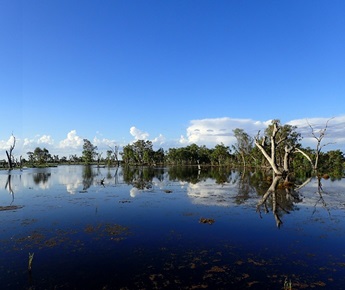Waterbird Tracker
The Waterbird Tracker is a web-based platform which enables the user to track the wetland use of 6 key waterbird species.
 The Waterbird Tracker project will help conserve our important wetlands. The platform is designed to help you learn about and collect information on our iconic waterbirds. We’ve started with 6 waterbirds – jabiru, brolga, swan, glossy ibis, magpie geese and spoonbills and want your help in collecting records for them. By participating, you also help others to learn more about these magnificent birds and their wetland homes and highlight threats that can harm their habitats, including their long-term survival across the region.
The Waterbird Tracker project will help conserve our important wetlands. The platform is designed to help you learn about and collect information on our iconic waterbirds. We’ve started with 6 waterbirds – jabiru, brolga, swan, glossy ibis, magpie geese and spoonbills and want your help in collecting records for them. By participating, you also help others to learn more about these magnificent birds and their wetland homes and highlight threats that can harm their habitats, including their long-term survival across the region.
It is a great way for local communities to track waterbirds and help NSW Department of Planning and Environment (Environment, Energy and Science) build a profile on the locations and activities of these waterbirds across the region. We can use waterbird profiles to assist landholders to promote and conserve local wetlands that are important to the long-term survival of waterbirds.
Record waterbird sighting
Why track waterbirds?
Many waterbirds rely on our inland rivers and wetlands for all or part of their life cycle. They can move across large areas of our region in search of suitable habitats that provide the different food types they need to survive. These habitats are the wet places in the landscape that need protection and regular water flows to be in a healthy condition to provide food and nesting places.
With your help, over time, the movement and locations of waterbirds will be better known across the northern region of the Murray-Darling Basin.
The Waterbird Tracker project will focus on 6 key species known to have populations in these regions:
- brolga (Grus rubicunda)
- black-necked stork (Ephippiorhynchus asiaticus)
- magpie goose (Anseranas semipalmata)
- black swan (Cygnus atratus)
- glossy ibis (Plegadis falcinellus threskiornithidae)
- spoonbills: royal spoonbill (Platalea regia) and yellow-billed spoonbill (Platalea flavipes)
The team
A team of people contributed to the creation of the Waterbird Tracker:
Daryl Albertson is a Senior Wetlands and Rivers Conservation Officer, North West Regional Operations (Armidale), with over 20 years working in the environmental field and water in the Gwydir, Border Rivers and Namoi Catchments. Since 2006, he has worked to restore the wetlands and deliver environmental water in the Gwydir, with advice from the local Environmental Water Advisory Group. Daryl initiated and developed this project, its process and content collaboratively with his team, in partnership with FeralScan (hosted by the Centre for Invasive Species Solutions).
Tim Hosking is a Senior Wetlands and Rivers Conservation Officer, North West Regional Operations (Dubbo). Tim provided advice regarding waterbird species and details regarding the Macquarie Marshes and Macquarie Valley, where he works with the local Environmental Water Advisory Group to manage environmental water.
Jane Humphries. When Jane was a Wetlands and Rivers Conservation Officer, North West Regional Operations (Moree), she provided advice regarding monitoring waterbird species. Jane undertook annual environmental monitoring across the north west and worked with the local Environmental Water Advisory Group to provide advice on the management of environmental water.
David Preston is an Assistant Environmental Water Officer, North West Regional Operations Division (Moree). David assists in the annual environmental monitoring program across the north west and has the role of technical officer to support the future development of the Waterbird Tracker platform.
Jennifer Spencer coordinates waterbird surveys for the department of Planning and Environment in the Gwydir Wetlands as part of statewide monitoring. She provided an advisory role during the development of the Waterbird Tracker project including provision of information on waterbird species. She is also involved with the Lake Brewster Pelican banding project.
Andy McQuie. When Andy was a Team Leader, Community Engagement North West Branch Regional Operations Division, he delivered a series of events to schools as a part of this project.
![]() The Waterbird Tracker project will help conserve our important wetlands. The platform is designed to help you learn about and collect information on our iconic waterbirds. We’ve started with 6 waterbirds – jabiru, brolga, swan, glossy ibis, magpie geese and spoonbills and want your help in collecting records for them. By participating, you also help others to learn more about these magnificent birds and their wetland homes and highlight threats that can harm their habitats, including their long-term survival across the region.
The Waterbird Tracker project will help conserve our important wetlands. The platform is designed to help you learn about and collect information on our iconic waterbirds. We’ve started with 6 waterbirds – jabiru, brolga, swan, glossy ibis, magpie geese and spoonbills and want your help in collecting records for them. By participating, you also help others to learn more about these magnificent birds and their wetland homes and highlight threats that can harm their habitats, including their long-term survival across the region.


